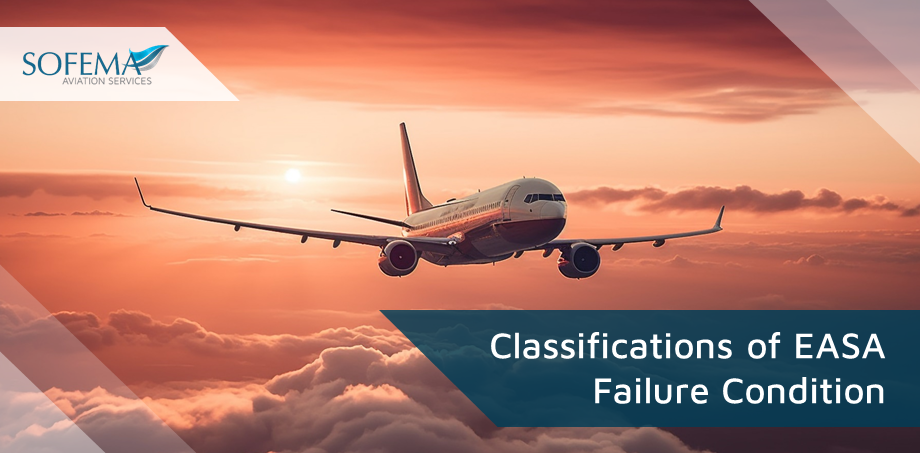Sofema Aviation Services (SAS) www.sassofia.com considers the terminology and descriptors used in support of CS25-1309 analysis in the EASA Failure Condition Classifications and Probability Terms
Introduction – Classifications
Failure conditions may be classified according to the severity of their effects as follows:
- No safety effect: Failure conditions that would have no effect on safety.
o For example, failure conditions that would not affect the operational capability of the aeroplane or increase crew workload.
- Minor: Failure conditions which would not significantly reduce aeroplane safety, and which involve crew actions that are well within their capabilities.
o Minor failure conditions may include, for example, a slight reduction in safety margins or functional capabilities, a slight increase in crew workload, such as routine flight plan changes, or some physical discomfort to passengers or cabin crew.
- Major: Failure conditions which would reduce the capability of the aeroplane or the ability of the crew to cope with adverse operating conditions to the extent that there would be, for example, a significant reduction in safety margins or functional capabilities.
o A significant increase in crew workload or in conditions impairing crew efficiency, discomfort to the flight crew, or physical distress to passengers or cabin crew, possibly including injuries.
- Hazardous: Failure conditions, which would reduce the capability of the aeroplane or the ability of the crew to cope with adverse operating, conditions to the extent that there would be:
o A large reduction in safety margins or functional capabilities.
o Physical distress or excessive workload such that the flight crew cannot be relied upon to perform their tasks accurately or completely, or
o Serious or fatal injury to a relatively small number of the occupants other than the flight crew.
- Catastrophic: Failure conditions, which would result in multiple fatalities, usually with the loss of the aeroplane.
- (Note: A failure condition which would prevent continued safe flight and landing should be classified as catastrophic unless otherwise defined in other specific AMCs. For flight control systems, continued safe flight and landing is defined in AMC 25.671, paragraphs 4 and 7.)
Qualitative probability terms
When using qualitative analyses to determine compliance with CS 25.1309(b), the following descriptions of the probability terms used in CS 25.1309 and this AMC have become commonly accepted as aids to engineering judgment:
- Probable failure conditions are those anticipated to occur one or more times during the entire operational life of each aeroplane.
- Remote failure conditions are those unlikely to occur to each aeroplane during its total life, but which may occur several times when considering the total operational life of a number of aeroplanes of the type.
- Extremely remote failure conditions are those not anticipated to occur to each aeroplane during its total life but may occur a few times when considering the total operational life of all aeroplanes of the type.
- Extremely improbable failure conditions are those so unlikely that they are not anticipated to occur during the entire operational life of all aeroplanes of one type.
Quantitative probability terms
- When using quantitative analyses to help determine compliance with CS 25.1309(b), the following descriptions of the probability terms used in this requirement and this AMC have become commonly accepted as aids to engineering judgment.
o They are expressed in terms of acceptable ranges for the average probability per flight hour.
Probability Ranges
- Probable failure conditions are those having an average probability per flight hour greater than the order of 1 × 10-5.
- Remote failure conditions are those having an average probability per flight hour of the order of 1 × 10-5 or less, but greater than of the order of 1 × 10-7.
- Extremely remote failure conditions are those having an average probability per flight hour of the order of 1 × 10-7 or less, but greater than of the order of 1 × 10-9.
- Extremely improbable failure conditions are those having an average probability per flight hour of the order of 1 × 10-9 or less.
Next Steps
Follow this link to our Library to find & download related documents for Free.
Sofema Aviation Services (www.sassofia.com) offers training to cover CS 25 System Safety Assessments. Please see the following course: Type Certification System Safety Assessment – 5 Days. For additional questions or comments, email team@sassofia.com
Tags:
aviation, aviation safety, Aviation SMS, Aviation Training, Cabin Crew, Certification Specification 25 (CS 25), EASA, Failure Condition Classification, Hazard, Regulatory Compliance, Safety, SAS blogs




